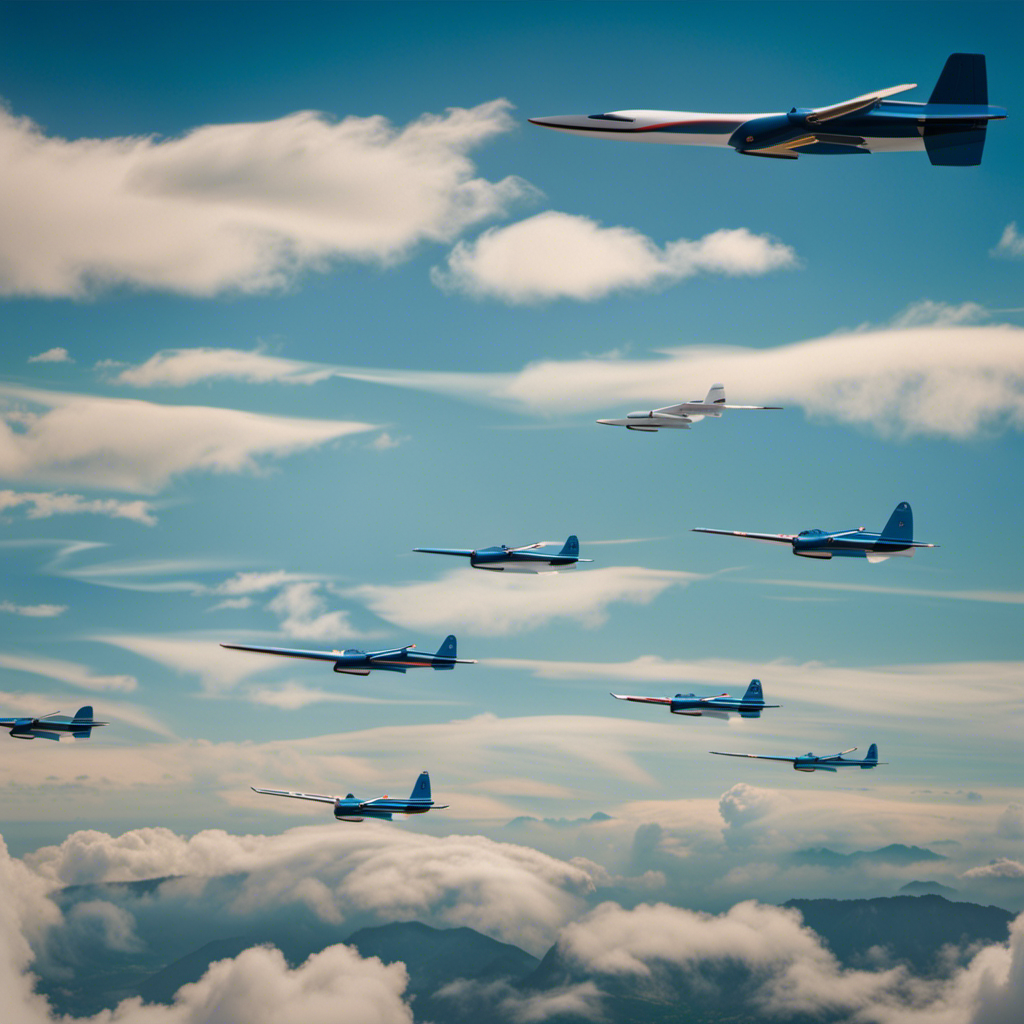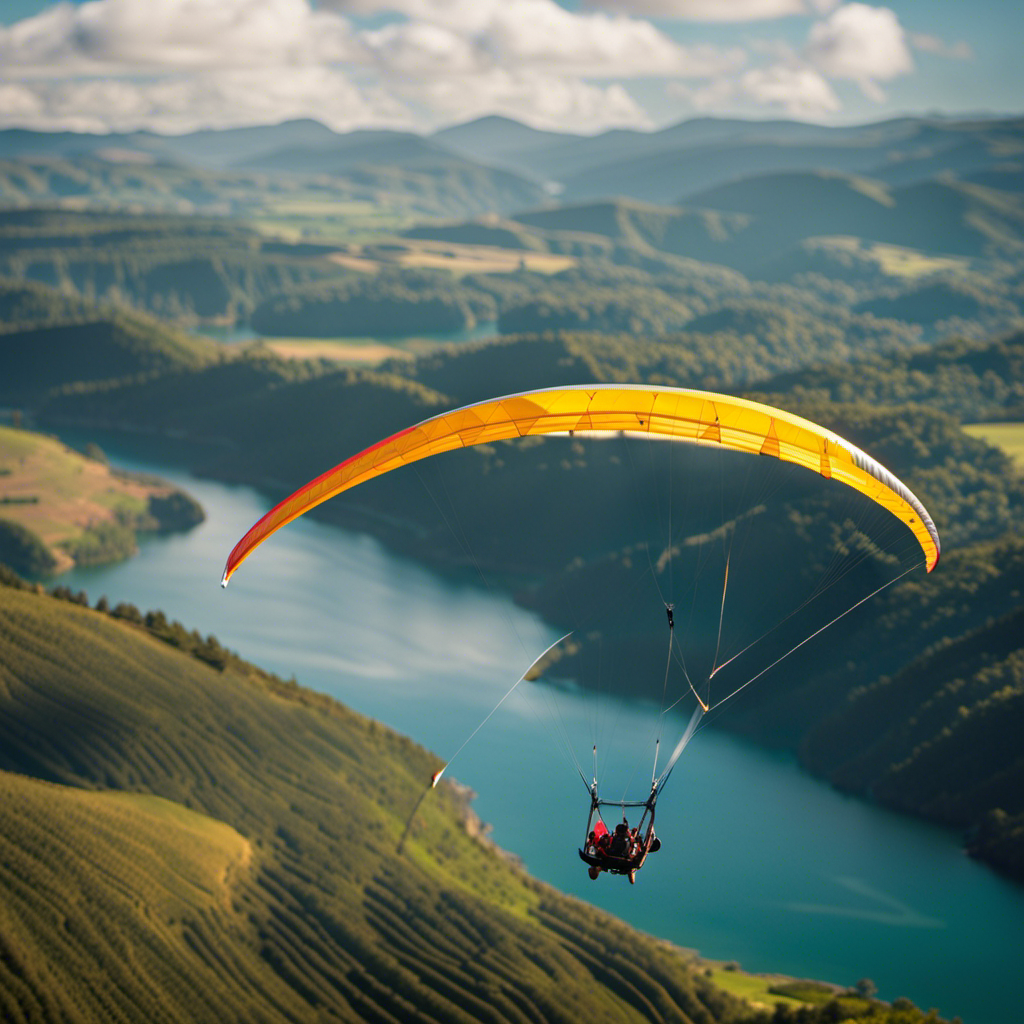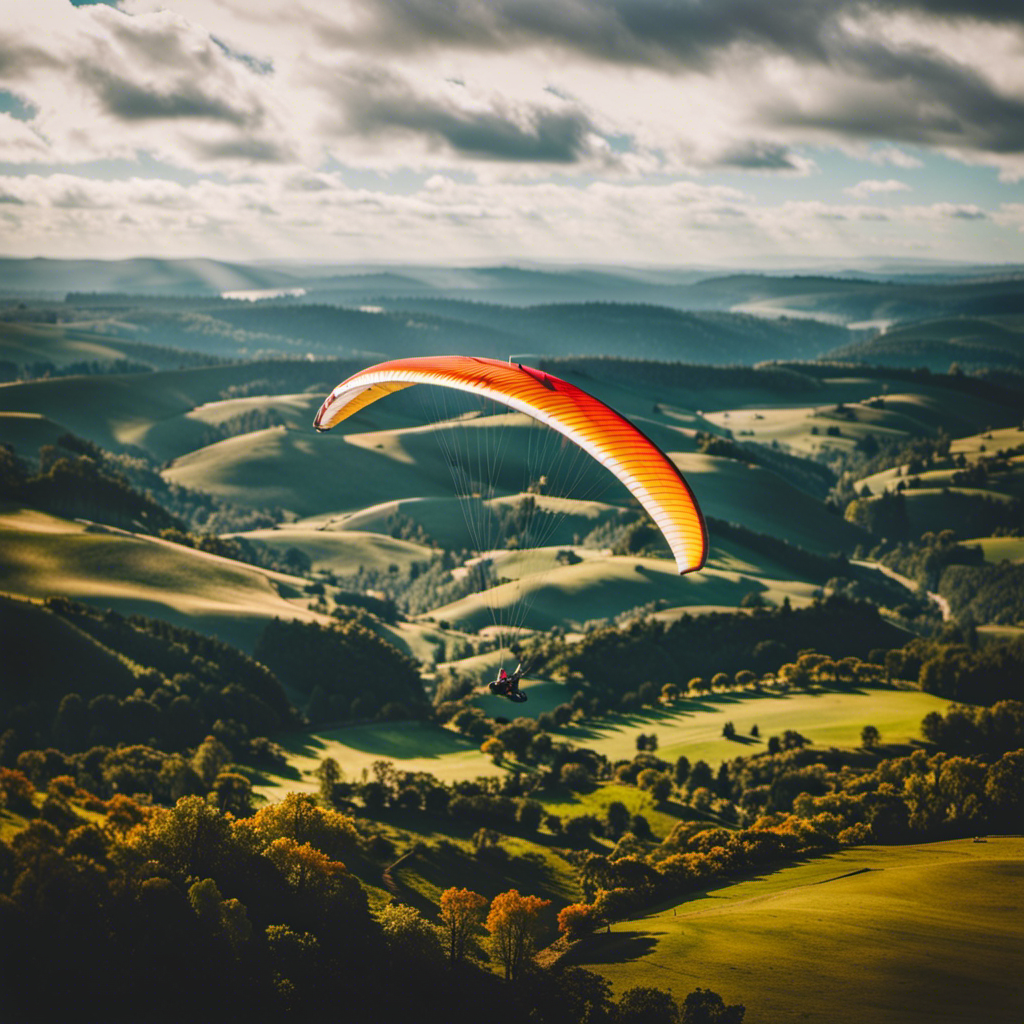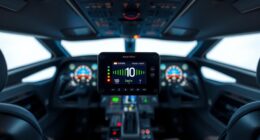While soaring through the endless expanse of the sky, I am amazed by the breathtaking views and the feeling of freedom that glider aircraft offer.
If you, like me, have always dreamt of owning your own glider plane, then you’ve come to the right place. In this comprehensive buyer’s guide, I will walk you through the types of glider planes available, the factors to consider when making a purchase, and the top brands in the market.
Get ready to embark on an incredible journey into the world of glider planes for sale.
Key Takeaways
- There are different types of glider planes available, including sailplanes, motor gliders, and aerobatic gliders, each with their own characteristics and advantages.
- When buying a glider plane, it is important to consider factors such as size, design, construction, and cost to ensure it suits your flying goals and experience level.
- Features and specifications to look for in a glider plane include wing span, aspect ratio, cockpit comfort and instrumentation, glide ratio, performance, and handling characteristics.
- Schempp-Hirth is a top glider plane brand known for their innovative designs, exceptional performance, attention to detail, and commitment to safety.
Types of Glider Planes Available
There’s a wide variety of glider planes available for purchase. When it comes to choosing the right one, it’s important to consider your flying goals and experience level.
The most common type of glider plane is the sailplane, designed for soaring and staying aloft with the help of natural air currents. These planes have a sleek and streamlined design, with long wings and a high aspect ratio to maximize lift.
Another type is the motor glider, which combines gliding capabilities with a small engine for added flexibility.
Additionally, there are aerobatic gliders designed for performing stunts and maneuvers in the air. Each type has its own unique characteristics and advantages.
Considering these factors will help you make an informed decision when buying a glider plane.
Factors to Consider When Buying a Glider Plane
When purchasing a glider plane, you should consider various factors. These factors will help you make an informed decision and ensure that you find the perfect glider plane for your needs. To assist you in this process, I have created a table that outlines the key factors to consider when buying a glider plane.
| Factor | Description |
|---|---|
| Size | Consider the size of the glider plane, including its wingspan, length, and weight. This will determine its maneuverability and performance. |
| Design | Look for a design that suits your flying style and preferences. Different designs offer varying levels of stability, speed, and efficiency. |
| Construction | Examine the materials used in the construction of the glider plane. Lightweight materials, such as carbon fiber, provide better performance and durability. |
| Cost | Determine your budget and find a glider plane that offers the best value for money. Consider not only the initial cost, but also maintenance and operating expenses. |
Features and Specifications to Look for in a Glider Plane
When it comes to choosing a glider plane, there are several key points to consider.
First, the wing span and aspect ratio play a crucial role in the performance of the aircraft. A longer wing span and higher aspect ratio generally result in better glide ratios and overall performance.
Additionally, cockpit comfort and instrumentation should not be overlooked, as they can greatly enhance the flying experience and provide essential information to the pilot.
Wing Span and Aspect Ratio
To determine the right glider plane for you, consider the wing span and aspect ratio. The wing span refers to the length of the wings from tip to tip, while the aspect ratio is the ratio of the wing span to its average chord. These two factors play a crucial role in the performance and handling of a glider plane. A longer wing span provides more lift and better maneuverability, allowing for smoother turns and improved gliding capabilities. On the other hand, a higher aspect ratio leads to reduced drag and increased glide efficiency. To help you understand the relationship between wing span, aspect ratio, and performance, take a look at the table below:
| Wing Span (m) | Aspect Ratio | Performance |
|---|---|---|
| 15 | 10 | Excellent |
| 18 | 12 | Superior |
| 12 | 8 | Good |
Glide Ratio and Performance
The glide ratio and performance of a glider plane are important factors to consider when choosing the right one for your needs. As an experienced pilot, I understand the significance of these factors in determining the overall efficiency and capabilities of a glider. Here are three key aspects to keep in mind:
-
Glide Ratio: This refers to the distance a glider can travel horizontally compared to the altitude it loses. A higher glide ratio means the glider can cover more ground while losing less altitude, resulting in longer flights and greater range.
-
Performance: A glider’s performance is determined by factors such as its maximum speed, climb rate, and maneuverability. High-performance gliders are designed for competitive flying and can offer thrilling experiences with their impressive speed and agility.
-
Handling Characteristics: Each glider has its own unique handling characteristics. Factors such as the responsiveness of the controls, stability, and ease of flying should be taken into account to ensure a comfortable and enjoyable flying experience.
Considering these factors will help you make an informed decision when selecting a glider plane.
Now, let’s move on to the next section, where we will explore cockpit comfort and instrumentation.
Cockpit Comfort and Instrumentation
Cockpit comfort and instrumentation are crucial for a pilot’s flying experience. A comfortable cockpit allows for focused flying without distractions. The seating position should be ergonomically designed to minimize fatigue during long flights. Instruments and controls should be placed and accessible for efficient operation. A well-designed cockpit layout allows for easy monitoring of critical flight data and ensures necessary controls are within reach. With a comfortable and well-equipped cockpit, pilots can fully enjoy gliding. Now, let’s explore the top glider plane brands on the market.
Top Glider Plane Brands on the Market
One of the top glider plane brands on the market is Schempp-Hirth. With a long-standing reputation for producing high-quality aircraft, Schempp-Hirth is known for their innovative designs and exceptional performance.
Their gliders are crafted with meticulous attention to detail, utilizing advanced materials and engineering techniques to ensure optimal aerodynamics and structural integrity. The company’s commitment to safety is evident in their incorporation of cutting-edge technology and safety features, providing pilots with peace of mind while soaring through the skies.
Schempp-Hirth gliders are renowned for their excellent handling characteristics and responsiveness, making them a top choice among glider enthusiasts worldwide.
When considering a glider plane purchase, it is crucial to conduct pre-purchase inspections and test flights to thoroughly evaluate the aircraft’s condition and performance.
Pre-Purchase Inspections and Test Flights
After researching the top glider plane brands on the market, it’s time to dive deeper into the process of purchasing a glider plane.
One crucial aspect to consider is the pre-purchase inspection and test flight. These steps are vital in ensuring that the glider plane you’re interested in is in optimal condition and meets your requirements.
During a pre-purchase inspection, a qualified technician will thoroughly examine the aircraft, checking for any mechanical issues or structural damage. Additionally, a test flight will allow you to experience the glider plane firsthand and assess its performance.
This comprehensive evaluation will provide valuable insights into the aircraft’s airworthiness and overall condition. Understanding the results of these inspections and test flights will help you make an informed decision when it comes to understanding maintenance and repair costs, which we will explore next.
Understanding Maintenance and Repair Costs
Understanding the maintenance and repair costs of a glider plane is crucial for prospective buyers. As an avid glider pilot, I have learned that these costs can vary depending on the age, condition, and type of glider.
Regular maintenance tasks such as inspections, lubrication, and adjustments are essential to ensure the safety and performance of the aircraft. Additionally, repairs may be necessary due to wear and tear, accidents, or component failures. These repairs can range from minor fixes to major overhauls, and the costs can quickly add up.
It is important to budget for these expenses and consider the availability of spare parts and qualified technicians. By understanding the maintenance and repair costs associated with owning a glider plane, buyers can make informed decisions and avoid unexpected financial burdens.
When it comes to finding glider planes for sale, there are various resources available.
Resources for Finding Glider Planes for Sale
When it comes to finding glider planes for sale, there are several resources available to enthusiasts.
Online marketplaces and classifieds provide a convenient platform to browse and purchase glider planes from sellers all over the world.
Additionally, glider plane dealers and brokers specialize in connecting buyers with the perfect aircraft, offering expertise and guidance throughout the purchasing process.
Lastly, attending glider plane trade shows and events is a great way to interact with industry professionals and explore a wide range of available options all in one place.
Online Marketplaces and Classifieds
Online marketplaces like eBay and classifieds such as Craigslist offer a wide selection of glider planes for sale. These platforms provide a convenient way for buyers to browse through various options and connect with sellers directly. When searching for glider planes on these online marketplaces, it is important to consider factors such as price, condition, and location. To assist you in your search, I have created a table below that highlights some key details to look for when considering a glider plane for purchase:
| Feature | Description | Importance |
|---|---|---|
| Price | The cost of the glider plane | High |
| Condition | The overall state and maintenance history | High |
| Location | The geographical location of the seller | Medium |
| Specifications | Wing span, weight, and other technical details | Low |
Glider Plane Dealers and Brokers
After exploring the world of online marketplaces and classifieds, let’s now delve into the realm of glider plane dealers and brokers.
When it comes to purchasing a glider plane, working with a reputable dealer or broker can provide invaluable expertise and guidance. These professionals have an extensive network and deep knowledge of the glider plane market, allowing them to assist buyers in finding the perfect aircraft that meets their specific needs and preferences.
Moreover, dealers and brokers can provide valuable insights into the condition, maintenance history, and performance capabilities of the glider planes they have available. By collaborating with these experts, buyers can rest assured that they are making an informed decision based on accurate information and expert advice.
Now, let’s explore another avenue for glider plane enthusiasts to gather and connect: glider plane trade shows and events.
Glider Plane Trade Shows and Events
Attending glider plane trade shows and events can offer enthusiasts a unique opportunity to connect with fellow aviation enthusiasts and explore the latest advancements in glider technology. These events bring together manufacturers, dealers, and buyers from all over the world, creating a vibrant and informative atmosphere.
You can witness firsthand the cutting-edge designs, materials, and features that are shaping the future of glider planes. From innovative wing designs to advanced cockpit instrumentation, you can get a glimpse of what’s on the horizon in the world of glider technology.
These events also provide a platform for networking and building relationships with industry professionals, which can be invaluable when it comes to negotiating the best price on a glider plane.
Tips for Negotiating the Best Price
When it comes to negotiating the best price, there are a few key strategies that can give you the upper hand.
First, it’s important to thoroughly research the market value of the item you’re interested in, as well as comparable sales in the area. This will give you a solid understanding of what a fair price range is and allow you to negotiate from a position of knowledge.
Additionally, building relationships with sellers can be immensely helpful in getting a better deal. By establishing a rapport and showing genuine interest, sellers may be more inclined to offer you a lower price or provide additional incentives.
Lastly, timing the purchase for off-season deals can also work in your favor. Sellers may be more motivated to sell during slower periods and may be willing to negotiate on price to close the deal.
Researching Market Value and Comparable Sales
Before starting your search for glider planes for sale, it’s essential to research market value and comparable sales. This step will help you determine a fair price and ensure that you are not overpaying for the aircraft.
To begin, gather information on recent sales of similar glider planes. Look for factors such as model, age, condition, and any additional features that may affect the price. Online marketplaces and aviation forums are great resources for finding this data. Additionally, consult with experts in the industry who can provide insight into current market trends and pricing.
By thoroughly researching market value and comparable sales, you will be equipped with the knowledge to negotiate the best price for your glider plane purchase.
Now, let’s move on to the next section: building relationships with sellers.
Building Relationships with Sellers
Once you’ve found potential sellers through online platforms or local aviation clubs, it’s important to establish rapport and trust with them. This will not only make the buying process smoother but also increase your chances of getting a good deal. Here are some key steps to building relationships with sellers:
- Communicate openly and honestly about your needs and budget.
- Ask questions about the glider’s history, maintenance records, and any modifications.
- Show genuine interest in the seller’s experiences and knowledge.
- Arrange a visit to inspect the glider in person, if possible.
- Negotiate respectfully and be willing to compromise.
By following these steps, you can establish a solid foundation with the sellers and gain their trust. This will put you in a better position to negotiate and finalize the purchase.
Now, let’s discuss timing the purchase for off-season deals.
Timing the Purchase for Off-Season Deals
To get the best deal on a glider, you’ll want to consider purchasing during the off-season. This is when demand is lower and sellers are more likely to offer discounts.
In general, the off-season for gliders is during the winter months, when flying conditions are less favorable. However, it’s important to note that availability may also be limited during this time, as some sellers choose to store their gliders or perform maintenance during the off-season.
Therefore, it’s crucial to start your search early and be proactive in contacting sellers. By doing so, you can take advantage of the lower prices and potentially negotiate even better deals.
Once you’ve found the perfect glider, it’s important to consider financing options and insurance considerations to protect your investment and ensure a smooth ownership experience.
Financing Options and Insurance Considerations
If you’re looking to finance your glider plane purchase, there are several options available. Here are some key considerations to keep in mind:
-
Bank Loans: Traditional loans from banks can provide competitive interest rates and flexible repayment terms.
-
Aircraft Financing Companies: These specialized companies understand the unique needs of aircraft financing and can offer tailored solutions.
-
Personal Loans: If you have good credit and a strong financial history, a personal loan may be an option to consider.
-
Seller Financing: Some sellers may be willing to provide financing directly, allowing for more flexibility in the terms.
-
Insurance Considerations: It’s essential to explore insurance options to protect your investment and ensure you’re covered in case of any accidents or damages.
Understanding the financing options and insurance considerations will help you make an informed decision when purchasing a glider plane.
Now, let’s delve into preparing for ownership and enjoying the glider plane experience.
Preparing for Ownership and Enjoying the Glider Plane Experience
Joining glider clubs and communities is a great way to immerse yourself in the glider plane experience. These groups provide a supportive and knowledgeable network where you can learn from experienced pilots, participate in group flights, and share your passion for gliding.
When it comes to training and licensing requirements, it is essential to undergo proper instruction to ensure safe and responsible flying. Obtaining a glider pilot license involves both theoretical and practical training, including flight hours and exams.
Safety guidelines and best practices are crucial to follow to minimize risks and ensure a smooth and enjoyable glider plane experience. These guidelines cover pre-flight checks, weather considerations, emergency procedures, and communication protocols. By adhering to these guidelines, you can enhance your safety and the safety of others while soaring through the skies.
Joining Glider Clubs and Communities
Discover the vibrant glider community by connecting with local clubs and fellow enthusiasts. Being part of a glider club not only provides opportunities for socializing and networking, but also allows you to learn from experienced pilots and stay updated on the latest trends and advancements in the field. Here is a table showcasing some popular glider clubs around the world:
| Glider Club | Location |
|---|---|
| Soaring Society | United States |
| British Gliding | United Kingdom |
| Gliding Federation | Australia |
| Deutscher | Germany |
| Federazione | Italy |
Training and Licensing Requirements
To become a licensed glider pilot, you’ll need to complete a minimum number of flight hours and pass written and practical exams. The specific requirements may vary depending on your country or aviation authority.
In the United States, for example, you must log at least 40 flight hours, including 20 solo flight hours, to be eligible for a glider pilot license. These flight hours are crucial for gaining experience and honing your skills in controlling and maneuvering the glider.
Additionally, you will need to successfully pass both written and practical exams that cover topics such as aerodynamics, weather, navigation, and emergency procedures.
Once you have obtained your license, it is important to familiarize yourself with safety guidelines and best practices to ensure a safe and enjoyable flying experience. Understanding and adhering to these guidelines will help you mitigate risks and maintain a high level of safety while soaring through the skies.
Safety Guidelines and Best Practices
Remember, always conduct a thorough pre-flight inspection to ensure that your glider is in proper working condition before taking off. Safety should be the top priority when flying a glider.
Start by checking the control surfaces for any signs of damage or wear. Inspect the wings and tail for any cracks or loose fittings. Check the cables and pulleys for proper tension and lubrication. Make sure the cockpit instruments are functioning correctly and the emergency equipment is readily accessible.
It is also important to review the weather conditions before every flight and be aware of any potential hazards such as strong winds or thunderstorms. Always follow the proper launch and landing procedures and communicate effectively with other pilots in the airspace.
Frequently Asked Questions
Can I convert a glider plane into a motorized aircraft?
Yes, it is possible to convert a glider plane into a motorized aircraft. This can be done by installing an engine and propeller, along with making modifications to the aircraft’s structure and systems.
What are the legal requirements for owning and operating a glider plane?
To legally own and operate a glider plane, you must have a pilot’s license specific to gliders, such as a Private Glider Pilot License. Additionally, you need to meet the medical requirements set by aviation authorities and adhere to any regulations regarding airspace and safety.
Are there any restrictions on where I can fly a glider plane?
Yes, there are restrictions on where I can fly a glider plane. Airspace regulations and local laws determine where gliders can operate, usually in designated areas away from congested airspace and airports.
Can I rent a glider plane instead of buying one?
Yes, you can rent a glider plane instead of buying one. Many glider clubs and flight schools offer rental options for those who want to experience the thrill of gliding without the commitment of purchasing a plane.
Are there any safety certifications or standards for glider planes?
Yes, there are safety certifications and standards for glider planes. These include requirements for structural integrity, emergency systems, and pilot training. It is important to ensure that a glider plane meets these standards before purchasing.
Conclusion
In conclusion, purchasing a glider plane is not just about acquiring a machine, but about embarking on an exhilarating journey.
As I reflect on the different types, factors to consider, and top brands available, I can’t help but be captivated by the possibilities.
The anticipation of pre-purchase inspections and test flights, along with the resources for finding glider planes for sale, heighten my excitement.
So, whether you’re a seasoned pilot or a novice, get ready to soar into the skies and experience the true freedom and serenity that glider plane ownership brings.
With a heart that soars as high as the skies, Aria, affectionately known as “Skylark,” is the driving force behind Soaring Skyways. Her journey into the gliding world began as a young dreamer gazing up at the soaring birds, yearning to experience the weightlessness and freedom they embodied. With years of experience both in the cockpit and behind the scenes, Aria’s commitment to the gliding community is unwavering.










